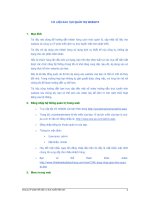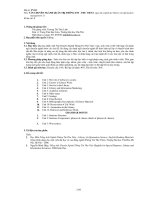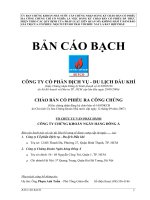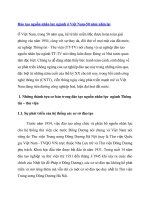Tài liệu đào tạo cố vấn dịch vụ của mercedes
Bạn đang xem bản rút gọn của tài liệu. Xem và tải ngay bản đầy đủ của tài liệu tại đây (10.23 MB, 74 trang )
Cars • Maintenance Technician (MT)
Engine Compustion
Basic Training
Working Document
Participant Document
A repeat order for this document or supplementary delivery can not be offered.
These documents are determined to be used in training programmes only and are not touched by current modification.
Printed in Germany
ã 2004 Copyright AutomotiveTraining GmbH
This work including all its details is protected by copyright. Reproduction, copying, revision, translation, distribution,
micro filming and data storing and/or use in electronic systems (including data banks and online services) of this
publication, wholly or in part, is only allowed with our previous written permission and with source credit.
1511 1495
02
-
st
1
edition
05.04
1,0
74
Index
Page
Title
1
Foreword
2
Combustible mixture
6
Mixture formation in gasoline engines
20
Ignition system at gasoline engines
34
Exhaust-gas treatment on gasoline engines
40
Mixture formation in diesel engines
54
Exhaust-gas treatment on diesel engines
58
Supercharging
66
Power and torque
68
Exhaust system
05/04
Basic Training for Maintenance Technician • Module Engine-Combustion
Index
I
05/04
Basic Training for Maintenance Technician • Module Engine-Combustion
Index
II
Foreword
Main objective
Basics motor combustion
The Maintenance Technician should be able to carry out inspections and
simple repairs competent and conscientiously with the provided instruments.
No matter if the combustion takes place according to the diesel or the gasoline principle there has to take place mixture formation, compression, ignition
and combustion. This learning unit introduces into the combustion process
and its involved systems. It shows alternatives of the power raise of combustion engines and clarifies questions to the formation of exhaust gases and its
treatment.
The Training modules should be carried out practically in conjunction with the
workshop information system WIS. Alongside the basics of the automobile
technology background information from the WIS is also being included.
The objective of these modules is the intermediation of basic physical knowledge. The MT should know terms and units, which he or she uses on a daily
basis in the field of work on the vehicle.
These subjects are being treated separately according to the combustion
principles of gasoline and diesel engines.
Target group of these Modules are ”Trainees” who have not absolved a technical apprenticeship and for previous professionals.
The participants can name and explain all components for the fuel-mixture
generation and exhaust gas treatment. They can obtain and use information
for the disassembly and assembly of an engine.
05/04
Basic Training for Maintenance Technician • Module Engine-combustion
Foreword
1
Combustible mixture
For a complete combustion of the fuel a certain amount of oxygen resp. air is
required. The blend of fuel and air is called mixture.
Now, first the fuel.
Fuel
Fuels and their placing in the vehicle have to fulfil certain requirements
regarding the suitability of combustion and the transport:
•
•
Simple and reliable formation of a combustible fuel-air mixture
which ignites very easily and fast and combusts fast and without
any residues.
Low weight and little space for the energy unit and the fuel container.
Besides, there are more fuels on the basis of regenerative (reusable) energies.
The following so-called alternative fuels are partly in use resp. partly in discussion:
•
Methane, produced partly of animal by-products,
•
Methanol, produced of wood-biomass,
•
Ethanol, produced of sugar-cane biomass,
•
Fail-safe transport.
•
Vegetable oil, produced of rape-biomass,
•
Immediate readiness for operation.
•
Hydrogen, produced of nuclear energy or solar energy.
•
Comfortable and possibly safe placing and transport in the vehicle.
Types of fuels
There are solid, liquid and gaseous fuels. Nowadays, however, only liquid and
limited gaseous fuels are significant. The best way to fulfil the abovementioned requirements is by using liquid fuels.
05/04
Common liquid fuels are gasoline and diesel. They consist of different hydrocarbons of the same origin (crude oil). Hydrocarbons are compounds of carbon (C) and hydrogen (H2). The manufacturing process starts with the distillation of the crude oil in its components. By further procedures the components
are being refined to gasoline and diesel.
Basic Training for Maintenance Technician • Module Engine-Combustion
Combustible mixture
The use of alternative fuels requires conversions on the engine, vehicle and
the infra structure of the fuel distribution. In the near future their use is only
expected in certain areas. In medium-term, methanol seams to be the most
promising alternative whereas the chances for hydrogen technology might be
given only for long-term.
2
Characters of fuels
The main character why fuels are being used for combustion at all is that they
have saved chemically bonded energy. The chemical energy the combustion
engine converts into mechanical energy (force).
The chemical energy of the fuel is being declared with the so-called specific
calorific value in joule per kilogram (J/kg).
Besides, fuels own certain characters concerning the readiness to ignite
themselves even under high pressure and temperatures. This readiness is
called ignition quality. The dimensional figure for the ignition quality is the
octane number (gasoline engine) and the cetane number (diesel engine).
The higher the octane number the more knocking resistant and therefore
high-graded is the fuel.
On petrol stations, the octane number is declared by the letters ROZ. ROZ
means Research Octane Number and equals to the international standardisation. Diesel fuel needs to have a high ignition quality in contrast to gasoline
fuel. As a reminder: The diesel principle is based on self-ignition.
The standard reference number for the ignition quality of diesel is the cetane
number. Beyond it, diesel fuel has got one more character. Diesel is getting
viscid at low temperatures and therefore becomes useless. From about –
24°C onwards the inspissation starts.
The table below shows the octane and cetane numbers for common fuels.
Gasoline fuel (petrol) should own a low ignition quality in order to prevent the
rest of the mixture from igniting automatically. As a reminder: The gasoline
engine ignites controlled by external ignition.
In this way the octane number characterises the safety of petrol against the
appearance of undesired self-ignition. Undesired self-ignitions are also called
knocking combustion. The knocking of the engine is feared because it can
come to destruction on the engine. The knocking noise mostly appears at low
rotational speed and full load (accelerating knocking) or at high rotational
speed (high-speed knocking).
05/04
Basic Training for Maintenance Technician • Module Engine-Combustion
Combustible mixture
Fuels
Octane-/cetane numbers
Petrol
91
Premium gasoline
95
Premium high grade gasoline
98-100
Diesel
50
3
Air demand
The air demand is the amount of air, which is needed for the complete combustion of a fuel. It is also called stoichiometric air demand.
Concerning the motor combustion in general one differs more or less from the
stoichiometric mixture ratio. The ratio of the actual air mass mL to the stoichiometric air mass is called air ratio λ.
3 different mixture conditions are being differed in the motor operation:
•
A mixture with air deficiency has got a λ < 1 and is called a “rich”
mixture.
•
A mixture with a stoichiometric mixture ratio has got a λ = 1
(ratio: fuel to air = 1 to 14,8) and is called stoichiometric mixture.
•
A mixture with excess air has got a λ > 1 and is called “lean”
mixture.
Nowadays, gasoline engines are almost exclusively equipped with a regulated
catalytic converter. Therefore it is necessary to operate them with nearly a
stoichiometric mixture.
Diesel engines are always being operated with excess air to avoid too much
soot production.
05/04
Basic Training for Maintenance Technician • Module Engine-Combustion
Combustible mixture
4
!
05/04
Basic Training for Maintenance Technician • Module Engine-Combustion
Combustible mixture
5
Mixture formation in gasoline engines
The treatment of gasoline fuels is being proceeded outside the cylinder with
the help of a carburettor (here not dealt with because not the state of technology anymore) by injection into the intake manifold or by direct injection
into the combustion chamber.
The pictures show the intake-manifold injection and the direct injection.
1
4
The following tasks must be fulfilled concerning the mixture formation and the
air-fuel-mixture metering:
•
3
Formation of a gaseous fuel-air mixture of delicately distributed
fuel.
•
Exact dose of the fuel for the desired air ratio.
•
Fuel metering of the mixture amount by throttle devices to adjust
the power.
2
1.
2.
3.
4.
AT_07.3_0006
Nozzle
Spark plug
Intake manifold
Exhaust channel
4
3
1
2
AT_07.3_0007
05/04
Basic Training for Maintenance Technician • Module Engine-Combustion
Mixture formation in gasoline engines
6
The mixture forming system is not only involved in the optimisation of the
combustion within the stoichiometric air ratio but also in further, essential
operating values:
•
Make possible a quick start.
•
Make possible a stable idle.
•
Operate economically in the part-load range.
•
React quickly upon load changes e.g. acceleration.
•
To deal with the fuel dose in a way to maintain the harmful exhaust-gas emissions possibly low in all conditions of operation.
•
To enrich the mixture with fuel to reach the maximum power.
•
To operate independently of the atmospheric condition.
Mixture composition
The mixture composition has got a large influence on the important operating
values. The fuel-air-mixture ratio or the air ratio is describing it.
The air ratio area in which gasoline engines can be operated is being determined by the rich and lean misfire limit resp. by according ignition limits.
Air ratio area of the gasoline engine: 0,5-0.7 < λ < 1,3-1,7
05/04
Basic Training for Maintenance Technician • Module Engine-Combustion
Mixture formation in gasoline engines
Basically the mixture ratio depends on:
•
the temperature of the engine,
•
the engine speed,
•
engine load (load).
Therefore, the following operational conditions of the engine require a rich
mixture:
•
cold start,
•
warm-up,
•
acceleration (full load),
•
high performance (full load).
Full load is the operational condition in which it is being driven with the throttle valve completely opened. This is independent from the rotational speed.
When the engine is warm and the engine load is low (so-called part load) it is
being driven economically with a lean mixture.
7
Mixture-formation facility at gasoline engines –
intake manifold injection
During the injection in the gasoline engine fuel is being pushed through a
pump and injected either individually in front of each cylinder (multi point fuel
injection) or centrally in the area of the highest air speed (single-point injection) by injection valves. At the single-point injection the injection of the fuel
happens by only one injection valve (single point) and at the multi point fuel
injection it happens by one injection valve per cylinder (multi point).
Principally, the intake-manifold injection happens either continuous or discontinuous.
•
Continuous operated systems are mechanic systems which inject fuel uninterrupted (continuous).
•
Discontinuous systems are being controlled by electromagnetic
valves. They are being controlled by an electronic control unit as
required and therefore they do not inject permanently (discontinuous).
In order to adapt the fuel flow to the airflow according to the desired air ratio
certain control systems are required. They are called mixture formation facilities. They have to be able to measure the air quantity or air mass as well as
control an allocation of the fuel quantity according to the measured air quantity. The injection valves count to further system components of the mixtureformation systems.
AT_07.3_0008.1
AT_07.3_0008.2
You can imagine the operation-dependant mixture formation as follows: The
driver demands a certain power of the engine by the position of the accelerator. The accelerator is connected to the throttle valve of the engine. The
throttle valve controls the load condition in the mixture-formation facility. If
more power is required, the throttle valve will open wider. Thereby a bigger
airflow can get into the combustion chambers. The air quantity is being measured. A larger quantity of fuel can be injected with the measured, larger air
quantity. This is how the engine gets more power.
How exact the mixture-formation facilities operate we will discuss later on.
05/04
Basic Training for Maintenance Technician • Module Engine-Combustion
Mixture formation in gasoline engines
8
Mechanic controlled, continuous multi point fuel injection (K-Jetronic)
At the so-called „K-Jetronic“ of the Bosch company the fuel quantity is being
injected continuously and dosed by the measurement of the sucked-in air
quantity.
By the opening of the throttle valve the sensor plate is also being opened.
This works because of the intake vacuum: When the throttle valve is open the
engine is able to suck-in a large quantity of air and therefore it takes the
sensor plate far into the air funnel.
The excursion of the sensor plate is in a strong context with the air quantity.
According to the excursion of the sensor plate, square slots are being
changed in their cross section by the control plunger in the fuel distributor.
Thereby, the fuel quantity is being dosed to the nozzles. The quantity of
square slots equals to the quantity of cylinders in the engine. The control
plunger is connected with the sensor plate by a linkage. The differentialpressure valve cares for a constant pressure above the metering slot. The
injection valves spray the fuel even at low flow rates very subtle and open at
a fuel pressure of about 3,3.
An electric pump (fuel pump) supplies the system with a pressure of about
5,7 bar, which is being held constantly by the pressure regulator. A pressure
store holds the pressure constant for a certain time even after the engine has
been shut down. This is needed to ease the starting of the hot engine.
AT_07.3_0009
The basic adjustment of the air ratio happens by an idle mixture screw at idle
status and virtually stays constant in the whole part-load area. For full load
the mixture enrichment is being made by altering the outline of the air funnel.
For the cold start (cold-start enrichment = rich mixture) serves a special coldstart valve. For the warm-up there is being used a warm-up regulator (controlpressure regulator) and an auxiliary-air device. The warm-up regulator adjusts
temperature dependent the control pressure, which acts on the control
plunger and regulates the excess fuel during the warm-up by increasing or
decreasing the control pressure.
05/04
Basic Training for Maintenance Technician • Module Engine-Combustion
Mixture formation in gasoline engines
9
Electro-mechanic controlled, continuous multi point fuel injection
(KE-Jetronic)
The development of K-Jetronic to KE-Jetronic happened by an electronic trunk
offer (basic system as K-Jetronic). Thereby, intelligent functions as e.g. λregulation can be realised on λ= 1 for the cleaning of the catalytic converter
or a warm-up enrichment. The advantage of the KE-Jetronic to purely electronic systems is the ability of limp-home because the basic system continues
to operate mechanically during a black out of the electronic.
Electronic controlled multi point fuel injection (L-Jetronic)
By the progress in the semiconductor technology the electronic control of the
injection quantity has been made possible. Therefore there is a multitude of
correction possibilities for an improvement of efficiency, tractability and
exhaust-gas emissions.
At the L-Jetronic the air quantity which is being inducted by the engine is
measured directly and the fuel quantity which is to be injected is being determined.
AT_07.3_0012
AT_07.3_0010
05/04
Basic Training for Maintenance Technician • Module Engine-Combustion
Mixture formation in gasoline engines
10
For the measurement of the air quantity there is a rectangular sensor plate in
the intake manifold of the engine. The sensor plate is being held by the airflow
against the return force of a spiral spring in a certain angle position. The
position of the sensor plate corresponds to a certain air quantity according to
the size of the cross section. A potentiometer measures the position and
enters the data in an electronic control unit. By the direct airflow measuring,
production tolerances and the wear of the engines are being compensated.
The control unit determines by means of the air quantity, the engine speed,
the temperature of the coolant and the oil, the air pressure, the course of
acceleration and the overrun with the help of program maps programmed in
advance the fuel quantity which has to be injected.
Injection valves
The injection takes place by injection valves, which are operated electromagnetically.
The injection valves consist of a nozzle needle with a solenoid armature and a
valve body with a solenoid winding. In a dead condition a spring pushes the
nozzle needle in its seal seat. At excitation by electric impulses of the control
unit the nozzle needle takes off the seat for approx. 0,1 mm and fuel can
come out of the annular orifice. The fuel supply takes place lateral or at the
back part of the valve.
AT_07.3_0011
AT_07.3_0013
05/04
Basic Training for Maintenance Technician • Module Engine-Combustion
Mixture formation in gasoline engines
11
The fuel is being delivered from the tank over an electric pump and a fuel
filter. The fuel filter keeps back impurities and has to be changed within the
maintenance intervals.
All injection valves of an engine are being selected by the control unit with
impulses at the same time. Therefore they inject at different phases of the
operating cycle of the individual cylinders.
In order to provide approximately same conditions for all cylinders, the injection quantity is being divided into 2 halves and injected twice per power cycle
of a cylinder (intermittent group injection). The mixture formation is being
improved by the forward shift of one part of the fuel in front of the closed
intake valve, which is caused thereby.
The control unit determines the injected quantity by the pulse duration of the
valves. The release of the control impulses happens from the distributor contact points in the ignition distributor.
Here is also integrated a cold-start device. For a safe cold start serves a very
subtle atomisable cold-start valve.
A contact set on the throttle valve shuts off the fuel supply completely in the
overrun above the engine idle speed and besides that controls the full-load
enrichment.
Electronic controlled injection (LH-Jetronic)
The basic system equals to the L-Jetronic. The development shows among
other things a change of the air-quantity measurement. Instead of the measurement of the air quantity with a sensor plate the air mass is being measured
with a hot-wire air-mass meter and since 1987 with the hot-film air-mass
meter.
05/04
Basic Training for Maintenance Technician • Module Engine-Combustion
Mixture formation in gasoline engines
AT_07.3_0014
A thin heated platinum wire resp. a platinum-film resistor is being cooled by
the air-mass flow. Thereby its electric resistance changes. In a amplifier component this change is being registered and the current raised by the wire resp.
the film resistor. And that is so far that a constant temperature rules in the
hot wire resp. in the film resistor. The current needed for that is a measure for
the intake air mass.
A further development is the cold-start enrichment. It is integrated in the
control unit and is being reached by the enlargement of the duration of injection or the injection frequency. Thereby the cold-start valve and the thermotime switch do not apply.
12
Motronic engine control (ME)
Motronic owns a single control unit where the whole engine control can take
place electronically.
There are different types of Motronic.
The table below gives you an overview of the Motronic variants and its installation in the different Mercedes engines:
ME-version
Engine
Types
Launch
Notes
ME-versions
Engine
Types
Launch
Notes
ME 1.0
119
120
129/140
210/129
140
September1995
Launch
ME 2.7.1
275
285
215/220
230/240
October 2002
relieves
ME 2.7
112
113
163/170
202/203
208/209
210/211
215/220
230
June 2000
relieves
ME 2.0
112/11
3
170/203
209/211
215/220
230
March resp.
October 2001
like ME 2.8, but
with AMG
specific
extents
05/04
ME 2.0
112
113
129/163
202/208
210/215
220
ME 2.1
104
111
129/140
170/202
208/210
August 1996
Launch
ME 2.7
137
220/215
January 2000
Launch
March 1997
Launch
Basic Training for Maintenance Technician • Module Engine-Combustion
Mixture formation in gasoline engines
ME 2.8
ME 2.8.1
13
Following functions comprises a modern Motronic generation:
05/04
•
Electronic controlled fuel-injection installation with an air-mass
meter.
•
Electronic controlled ignition system.
•
Idle speed regulation: Because of turning on consumers (cooling
fan, air-conditioner compressor, etc.) during the idle, the idle
speed sinks and varies and the Motronic regulates against it.
With it a stable idle speed can be reached.
•
Lambda-regulation.
•
Knock control: On each cylinder there is a knock sensor (microphone) which recognises a combustion knock. As soon as a
knocking occurs the sensor reports it to the Motronic. Thereupon, the moment of ignition is being adjusted to “retard”. If then
the knocking stays away the moment of ignition will be adjusted
gradually in the direction “advance”.
•
Electronic pressure-charging regulation (only in connection with a
supercharger).
•
Control of the exhaust-gas recirculation.
•
Camshaft control.
Basic Training for Maintenance Technician • Module Engine-Combustion
Mixture formation in gasoline engines
•
Control of the variable-intake manifolds. At some vehicles the
length and the geometry of the intake channels can be altered in
order to have an improvement of the rotating speed according to
the point of operation.
•
Cruise control device regulation.
•
The opening speed of the throttle valve is being adapted to the
driving style of the driver (ME 2.8).
•
Pressure sensor in the intake manifold for the recognition f the
altitude (the air pressure sinks with the altitude) (ME 2.8).
Besides, the Motronic supports the control units of the other vehicle systems.
Therefore, there is e.g. a connection with the control unit of the automatic
gearbox. While switching a rotating speed reduction will set in, in order to
preserve the gearbox and to increase the comfort. The anti-slip regulation
(ASR) permits the connection with the ABS-control unit to increase the driving
safety. Further connections exist at vehicles with ESP between the control
unit of dynamics of vehicular operation and the Motronic. Therefore controlled
drive and brake actions can be done.
14
Block diagram of the ME-Motronic
Entry (Sensors)
Processing
Engine speed / induction-type pulse-generator
Control unit
Ignition TDC of the first cylinder / Hall generator
Basic coordination of the program
map
Start control
Air mass / air-mass meter
Position of the throttle valve /
Throttle valve potentionmeter
Engine temperature / NTC -engine
Post-start phase, full load, acceleration
enrichment
Overrun fuel cutoff
Engine-speed limitation
Lambda closed-loop control
Output (Actuators)
Main relais
Fuel-pump relais /
fuel pump
Injection valves
ETC-servomotor
Tank-ventilation valve
Idle-speed control
Exhaust-gas oxygen before cat. conv. / lambda sensor I
Tank-ventilation system
Exhaust-gas recirculation-valve
Exhaust-gas recirculation
Intake-manifold pressure / pressure sensor
Differential pressure / pressure sensor
Exhaust-gas oxygen after cat. conv. / lambda sensor II
Ignition TDC of the first cylinder / Hall generator
Torque guide
Crude-oil function
Cruise control
Load-changes regulation
Secondary-air injection
EOBD II
Shutoff valve
Heating lambda sensor I
Heating lamda sensor II
Secondary-air valve
CAN-bus-system
Position of accelerator / accelerator potentiometer
05/04
Basic Training for Maintenance Technician • Module Engine-Combustion
Mixture formation in gasoline engines
Secondary-air pump
15
Gasoline direct injection
This is a relatively new procedure of the inner mixture formation, which has
been introduced by Mitsubishi in 1997.
At direct injection systems the fuel is being injected directly into the combustion chamber by electromagnetic operated injection valves. An injection valve
is assigned to each cylinder. The mixture formation takes place within the
cylinder.
During the operation the engine only takes in air and no longer the fuel-air
mixture as with conventional injection systems. There is an advantage of the
new system: In the intake manifold no fuel will be condensed anymore and
cause high exhaust-gas values.
By the external mixture formation the fuel-air mixture exists generally homogenous (subtle and even mixed) in the stoichiometric ratio in the whole
combustion chamber. Whereas the mixture formation in the combustion
chamber allows two completely different modes of operations:
• Statified-charge operation: Different layers of the fuel-air mixture are being formated by swirl movement. Thereby, a
mixture of different air ratio is layered in
the combustion chamber. In the statifiedcharge operation the mixture only in the
area of the spark plug has to be ignitable.
In the other part of the combustion
chamber there is only fresh A/F mixture
and residual exhaust gas without noncombusted fuel. In the idle and part-load
range results therefore an overall very
lean mixture (fuel-air mixture approx.
1:40). The petrol consumption is also
being reduced. But because it is not
driven at λ = 1 the use of a new catalyticconverter technology is necessary.
AT_07.3_0015.1
• Homogeneous operation: As with the external mixture formation a homogeneous
mixture exists in the whole combustion
chamber with the homogeneous operation. The whole fresh air in the combustion chamber takes part in the combustion. Therefore this mode of operation is
being used with full load.
AT_07.3_0015.2
05/04
Basic Training for Maintenance Technician • Module Engine-Combustion
Mixture formation in gasoline engines
16
Tasks:
1. What is meant by mixture formation at combustion engines?
4.
What is meant by the mixture ratio of the fuel-air mixture? The ratio of...
a
Mixture of gasoline and premium gasoline
a
fuel to air.
b
Formation of fuel-air mixture
b
diesel fuel to gasoline fuel and air.
c
Formation of air ratio and octane number
c
basic gasoline to additives and air.
2. What does gasoline and diesel consist of?
5.
What means ignition quality? How is the ignition quality called at gasoline
and diesel engines?
3. What are alternative fuels? Name 3!
6.
What means λ = 1?
05/04
Basic Training for Maintenance Technician • Module Engine-Combustion
Mixture formation in gasoline engines
17
7. Which statements are correct?
a
Gasoline fuels should posses a low ignition quality.
a
Cold-start, warm up, acceleration, high performance
b
Gasoline fuels should posses a high ignition quantity.
b
Only at high performance
c
Diesel fuels should posses a low ignition quality.
c
Only at cold-start and high performance
d
Diesel fuels should posses a high ignition quality.
8. Which statements are correct?
11. The mixture ratio of fuel to air depends on...
a
A rich mixture possesses a λ > 1.
a
Torque, temperature and load of the engine.
b
A rich mixture possesses a λ < 1.
b
Torque, load and piston weight of the engine.
9. When is the throttle valve of the engine completely opened? Does this
depend on the torque?
05/04
10. Which modes of operation requires a rich fuel-air mixture?
Basic Training for Maintenance Technician • Module Engine-Combustion
Mixture formation in gasoline engines
12. How many injection valves are there at the single-point intake-manifold
injection on a 4-cylinder engine?
18
13. Is the fuel quantity being adapted to the air quantity and the other way
round?
15. What are the differences between a Motronic and a K-Jeronic?
14. Describe a mixture formation unit of your choice!
16. By which dimension “knows” the control in the hot-wire air-mass meter
which air mass has been taken in?
05/04
Basic Training for Maintenance Technician • Module Engine-Combustion
Mixture formation in gasoline engines
19
Ignition system at gasoline engines
The job of the ignition is to ignite the compressed air-fuel mixture at the right
time and thereby induce the combustion. The right time is called ignition
point. In the gasoline engine this happens by an electric spark between the
electrode and the spark plug. An assumption for a perfect operation of the
engine and the catalytic converter is an ignition operating properly under all
conditions. Misfiring lead to a bad engine performance, high consumption and
to damage on the catalytic converter due to overheating. By the afterburning
of the non-combusted mixture in the catalytic converter it overheats.
Moment of ignition
The moment in which the mixture has to be ignited essentially depends on:
•
Rotational speed
The combustion time of the mixture at a constant air-fuel mixture
is steady. Approx. 2 milli seconds pass from the moment of ignition until the complete combustion. If the engine speed increases, the time for the power cycle will decrease. Therefore, at
high rotational speed there has to be ignited earlier.
For the generation of the ignition spark generally high-voltage ignition-systems
have succeeded. They consist of the spark plug(s) and the actual ignition
system to generate the needed high voltage.
•
Load
At low loads the mixture is growing lean, the residual exhaust gas
portion increases and the filling decreases. This impact causes a
higher ignition lag and a lower rate of combustion in the mixture
so that there has to be ignited earlier.
For these reasons there is an adjusting device in the ignition system, which
regulates the ignition point, depending on the load and the rational speed.
05/04
Basic Training for Maintenance Technician • Module Engine-Combustion
Ignition system at gasoline engines
20
It is usual to relate the ignition point on the position of the crankshaft to the
top dead centre (TDC). It is declared as an angle in degree before TDC. There
are 2 adjustment variants to be differed:
•
Retard adjustment: adjusting of the ignition angel in direction of
the TDC,
•
Advance adjustment: adjusting in the TDC in the opposite direction.
The choice of the ignition point influences on various ignition processes and
results:
05/04
•
Maximum engine performance,
•
Fuel consumption,
•
Drivability,
•
Emissions,
•
Tendency to knock:
knocking is a non-controlled combustion in the engine. It is being
produced by an impulsive combustion of mixture parts, which
have not been reached by the flame front. In this case the ignition point lies too far in the direction “advance”. Knocking operation leads to a raise in temperature and a steep raise of the pressure in the combustion chamber. Pressure pulsation result from
it, which overlay the regular pressure characteristic. Damage can
occur on cylinder head, cylinder head gasket, bearings and pistons. There is a difference between the acceleration knock (at
low rotational speed and high loads) and high-speed knock (high
rotational speed and high loads).
Basic Training for Maintenance Technician • Module Engine-Combustion
Ignition system at gasoline engines
AT_15_0012
1. Ignition point at the right time
2. Ignition point too early
3. Ignition point too late
21









